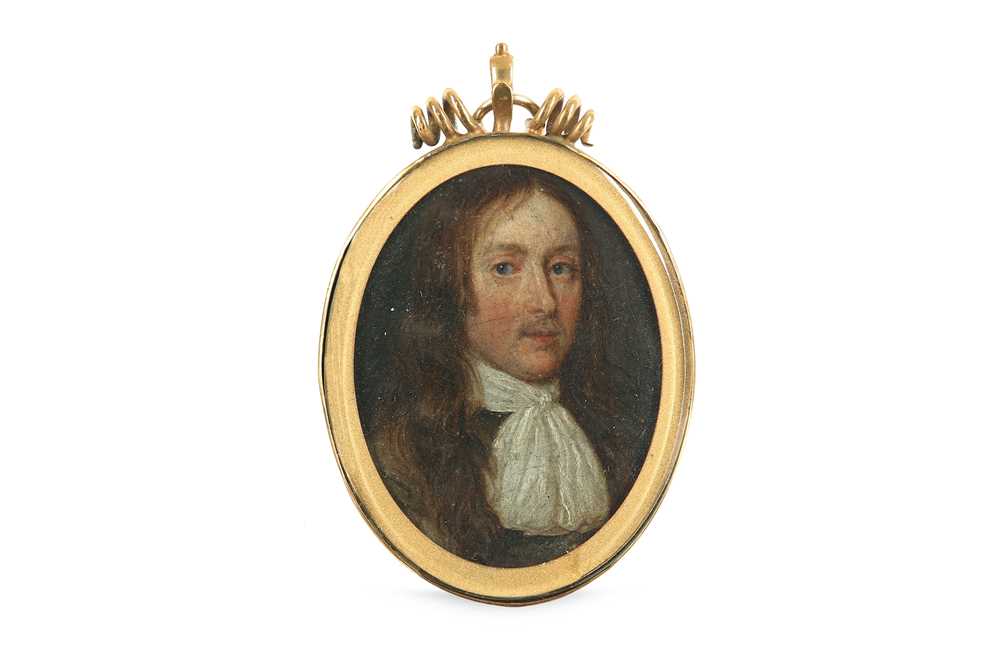25th Mar, 2020 12:00
Fine Portrait Miniatures including The Comerford Collection
ENGLISH SCHOOL (circa 1640) Portrait miniature of a Gentleman, probably John Hampden (1595-1643), wearing a brown coat and tied lawn jabot, his brown hair worn long Oil on card Later gilded metal frame with spiral cresting Oval, 53mm (2 ⅛in) high Provenance: J. Pearson, 1905; Hall Place, Leigh, Kent, sold on the instructions of the Executors of Sonja, Lady Hollenden )1919-2014), wife of Gordon Hope, 3rd Baron Hollenden John Hampden was one of the most influential men to hold power during the period of the English Civil War and was one of the main challengers to the royal authority of Charles I. Hampden was the first cousin of Oliver Cromwell and was educated at Oxford University and at the Inner Temple in London, before entering the House of Commons in 1621. David Piper described him as ‘a typical member of the landed gentry infected with puritanism’; he was at the frontline in the events that led to the outbreak of war, determined to bring the king to his knees. He became a national figure when he stood trial in 1637 for his refusal to be taxed for ship money, a system imposed by Charles I to pay for naval defences. The trial aroused great public interest and although the verdict was not in Hampdens favour, it was a great moral victory. The decision, wrote the historian Edward Hyde, 1stEarl of Clarendon (a contemporary of Hampden), ‘proved of more advantage and credit to the gentleman condemned than to the King’s service’ and the reasoning of the judges ‘left no man anything he could call his own’. Hampden gained a national reputation through his actions and his beliefs were echoed throughout England, making a popular spokesman for integrity in Parliament. He was nicknamed “The Patriot”as illustrated by Clarendon (a contemporary of his) who wrote, ‘When this parliament began … the eyes of all men were turned on him as their Patriae Pater, and the pilot that must steer their vessel through the tempest and rocks which threatened it’. After the outbreak of the Civil War, Hampden was appointed to the Committee of Safety – the Parliamentary War Cabinet. On 18thJune 1643 at the Battle of Chalgrove he was shot in the shoulder and died six days later, on his wedding anniversary. This account of his death was given by Sir Robert Pye his son-in-law: ‘That in the action of Chalgrove Field, his pistol burst and shattered his hand in a terrible manner. He, however, rode off and got to his quarters but finding the wound mortal he sent for Sir Robert Pye then a colonel in the Parliamentary army - and who had married his eldest daughter - and told him that he looked on him in some degree accessory to his death as the pistols were present from him. Sir Robert assured him that he bought them in Paris from an eminent maker and proved them himself. It appeared on examining the other pistol that it was loaded to the muzzle with several supernumerary charges, owning to the carelessness of a servant. He was ordered to see that the pistols were loaded every morning which he did but without drawing the former charge.’ The iconography of this controversial character is far from straightforward, with no ad vivum portrait yet come to light. The features in this portrait accord closely with the engraving by Jacobus Houbraken, after a portrait owned by Sir Richard Ellys (1674?-1741/2) who married Hampden’s granddaughter. D. Piper (compiler), Catalogue of seventeenth-century portraits in the National Portrait gallery (1625-1714), Cambridge University Press, 1963, p.155
Sold for £1,375
Includes Buyer's Premium
Do you have an item similar to the item above? If so please click the link below to submit a free online valuation request through our website.
